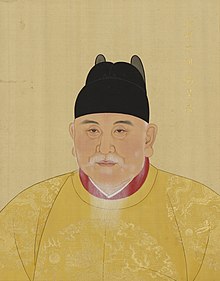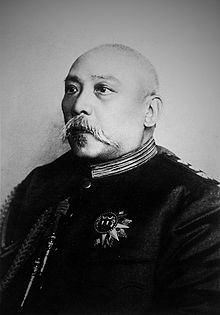Han nationalism
This article has multiple issues. Please help improve it or discuss these issues on the talk page. (Learn how and when to remove these template messages)
|
Han nationalism is a form of
Han people also constitute a sizable ethnic minority or plurality group in a number of other countries, such as Malaysia and Singapore. In the modern era, ethnicity's role in the Chinese nation continue to color conceptions of Chinese culture, geopolitics, and history. Han nationalism is to contrasted with the opposing concept of local ethnic nationalism.
| Han nationalism | |
|---|---|
Hanyu Pinyin | Hàn mínzú zhǔyì |
| Bopomofo | ㄏㄢˋ ㄇㄧㄣˊ ㄗㄨˊ ㄓㄨˇ ㄧˋ |
History


Unlike
Since the Han dynasty, ideas of Han Chinese superiority have been frequently used in attempts to expand China's territory. Examples of this can be seen in previous Chinese invasions of Korea and Vietnam, and in historical conquests of Central Asia, Tibet, Xinjiang and Mongolia.[3][4][5] This was later inherited by later dynasties of China, notably the Tang dynasty and the Ming dynasty. The Tang dynasty exerted control beyond the border of old Huaxia, allowing the later Ming dynasty to become a major naval power. Han Chinese ideas of superiority were complex, with contrasting Confucian narratives of Han superiority and ones of diversity in the army and the Empire.[6][7][8][9]
Han Chinese nationalism also played a key part in rallying against non-Han control of China. The Han Chinese nationalist movement led by
Following the fall of the Qing dynasty, Sun Yat-sen attempted to build a more multi-ethnic form of Chinese nationalism. He had some noteworthy successes, such as the rise of
Han chauvinism

It appeared again in a 1956 speech, titled
The PRC's notions of Han chauvinism and China as a multicultural state have been subjected to criticism, mainly by the western media. One critical view is that the Han Chinese "are less homogeneous than official policy recognizes".[19] Zhonghua minzu has been criticized as an invention of the 20th century, and was adopted by the Communist Party only to criticize the failures of the rival Kuomintang (KMT), which officially promoted zhonghua minzu as part of its nationalist ideology. Many policies have been made to give privilege to minority ethnicities, leading to grudges from some of the Han Chinese.[20] Despite this, authorities in China have also denied the existence of racism or racial discrimination in China.[21]
In post-Mao China, Han chauvinism has been recognized as a threat by successive generations of its leadership, including the
Relations with Chinese nationalism



Although Han Chinese nationalism and Chinese nationalism are different in terms of ideology, with the latter often emphasizing a more multi-ethnic form of nationalism, both forms of nationalism have frequently been connected and espoused together, due to historical and current control of China by the ethnic Han Chinese majority. The concept was first debated in the early 20th century; one of those who debated it was
The multifaceted image of Han Chinese nationalism continued to develop during the formation of the modern Chinese state. Han Chinese nationalists had a low opinion of ethnic
In ethnic relations

Although the current Chinese government has largely attempted to promote the idea of a multiethnic nationalism with Han Chinese is the main people instead of a singular ethnic nationalism, scholars and analysts have pointed about the lack of an agreed-upon definition of Chinese nationalism may have impacted on China's political decision with regard to other non-Han people and non-Chinese nations.[33][16][34][35]
Tibetans
Since the
Uyghurs
Since being conquered in 1758, Uyghurs from Xinjiang have had issues with the Chinese government. Han migration dating back to the Qing dynasty led to the increasing sinicization of the region, which the policy further extended to ethnic relations.[40] Han and Hui people often live closer to Uighurs and many developed a negative stereotype of them.[41] The Chinese government's repressive policies in Xinjiang since 2014 are often characterized as a genocide.
Mongols
Inner Mongolia has been largely pacified since the 20th century, thanks to massive Han migration and intermarriage; Mongols have been perceived to be better integrated into the society than that of Uyghurs and Tibetans.[42] However, this is also where the infamous Inner Mongolia incident happened, leading to deaths of 16,000 to 27,000 Mongols.[43] Further policies deemed to be anti-Mongol by the Han Chinese government had led to 2011 Inner Mongolia unrest and was followed by another wave of unrest in 2015 against the exploitation and misuse of Mongol lands, as well as perceived bias in favor of ethnic Han Chinese.[44]
See also
- Sinicization
- Anti-Qing sentiment
- Chinese imperialism
- Chiangism
- Hua–Yi distinction
- Hanjian
- Racial nationalism
- Racism in China
- Yamato nationalism(Japan)
- Yan Huang Zisun
References
- – via journals.openedition.org.
- S2CID 209509370.
- ^ "Selections from the Han Narrative Histories". depts.washington.edu. Retrieved 8 September 2020.
- S2CID 144507019.
- JSTOR j.ctt1dnn9vg.
- ISBN 978-0-19-973413-9
- ^ "Effects of Tang Imperialism on Its Eastern Neighbors". 4 June 2009.
- ^ "An introduction to the Ming dynasty (1368–1644) (article)". Khan Academy.
- ^ Hong, Wontack. "A Tripolar Approach to East Asian History" (PDF).
- ^ "Decline of the Yuan Dynasty". oer2go.org.
- OCLC 1156899651.
- ^ "Top Rebels in Ancient China". 18 September 2019.
- ^ Miller, Frederic P.; Vandome, Agnes F.; McBrewster, John. Anti-Qing Sentiment. ASIN 6130642490.
- ^ "The Boxer Rebellion: The West and the Rebels". OpenLearn. Retrieved 8 September 2020.
- ^ Field, Lydia. "The Chinese Dream: Cultivating Expansionist Chinese Nationalism in the South China Sea and the Role of Weibo". pp. 58–59.
- ^ S2CID 146969772.
- ^ Tse-tung, Mao. "Criticize Han Chauvinism". www.marxists.org. Retrieved 23 November 2018.
- ISBN 9789622016156.
- ^ ISBN 9780521786423.
- ISBN 9781441134899.
- ISBN 978-1137030849.
- ^ Meyer, Patrik. "Could Han Chauvinism Turn the 'Chinese Dream' into a 'Chinese Nightmare'?". thediplomat.com. The Diplomat. Retrieved 6 October 2020.
- . Retrieved 6 October 2020.
- ^ S2CID 209509370.
- OCLC 678575064.
- ^ Marsh, Jenni (26 May 2020). "China says it has a 'zero-tolerance policy' for racism, but discrimination towards Africans goes back decades". www.cnn.com. CNN. Retrieved 22 August 2020.
- ^ "Genocide as Nation Building: China's Historically Evolving Policy in East Turkistan". Journal of Political Risk. 7. 29 August 2019.
- ISBN 9789882377844– via Project MUSE.
- ^ Sperling, Elliot (2004). "History and Polemics". East-West Center – via JSTOR.
- ^ Dai, Tinglan. "The Great Han: The Development, Evolution, and Influence of Chinese Ethnic Nationalism on Modern Chinese Society and Government" (PDF).
- ^ "Han Nationalism in China". Al Jazeera Center for Studies.
- S2CID 54202582.
- ^ Townsend, James. "Chinese Nationalism" (PDF). The Australian Journal of Chinese Affairs.
- OCLC 1125804033.
- ISBN 978-1-349-33608-1.
- ^ PMID 28553018.
- ISBN 978-0-520-24464-1.
- ISSN 0190-8286. Retrieved 9 September 2020.
- ^ "Friedman: Chinese Believe Tibetans, Other Ethnic Groups Should be Incorporated into One China". Council on Foreign Relations. Retrieved 9 September 2020.
- .
- ISBN 978-90-04-16675-2. Retrieved 28 June 2010.
- ^ Qin, Amy (31 August 2020). "Curbs on Mongolian Language Teaching Prompt Large Protests in China". The New York Times.
- S2CID 161598031.
- ^ Wu, Zhong (8 June 2011). "Green motives in Inner Mongolian unrest". Asia Times. Archived from the original on 12 July 2011. Retrieved 11 June 2011.
{{cite news}}: CS1 maint: unfit URL (link)
